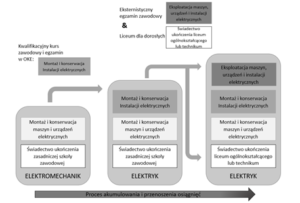This page is about the use of ECVET in the organization of the vocational education system, the use of ECVET in professional mobility is devoted to a separate page.
The assumptions underlying ECVET are reflected in formal education in the vocational education and training system in Poland. This system was significantly reformed in 2012 and 2017-2019, although key preparatory work started already in 2008.
After the political transformation, vocational education was not in the center of attention, general education and higher education were much more promoted. However, since the end of the first decade of the 21st century, adapting vocational education to market needs and making the vocational training offer more attractive for young people and adults has become one of the priorities of public policy in the field of education (Drogosz-Zabłocka, Sztanderska, 2019).
This change resulted from competence shortages caused by economic changes and mass emigration of young Poles after joining the European Union in 2004. Increasing attention was focused on vocational education and training also at the EU level.
The main aim of the reforms was to ensure a positive change in educational practice and the perception of vocational education and training in Poland. The changes concerned, among others modernization of the core curriculum and changes in the qualification structure, including the introduction of learning outcomes. These changes were supported by information, preparatory and implementation activities.
The implementation of ECVET principles is strongly related to the gradual revival of the vocational education system in Poland (although the basic problems related to the (under) financing of vocational education and the preparation of professional teachers have not been solved). The new qualifications structure was used to increase the market value of diplomas, the flexibility of vocational education and training and the degree of adaptation to labor market needs.
Qualifications, groups of learning outcomes and their verification
The core curriculum for vocational education from 2012 included over 200 school occupations, in which over 250 qualifications were distinguished. Most of the occupations included in the core curriculum consisted of 1-3 qualifications, however, another reform reduced the number of qualifications in the occupation to two. Despite this, the number of professions and qualifications did not change significantly, at the time of the publication of the core curriculum for vocational training in 2019, it was 215 professions and 254 qualifications, respectively.
The core curriculum for vocational education is described in terms of learning outcomes. Learning outcomes are defined for qualifications distinguished in a given profession, but also for the entire profession. It is worth knowing that learning outcomes also serve as exam requirements – on the basis of these, the Central Examination Commission prepares vocational exams. Additionally, the core curriculum for vocational education defines the requirements related to the provision of vocational education, including practical vocational training.
The structure of the core curriculum for vocational education provides for clearly defined groups of learning outcomes. There are several groups of learning outcomes that are common to all professions, including e.g. occupational health and safety, starting and running a business, a foreign professional language (although from 2019 they are included in every qualification in the profession and may be adapted to the specificity of profession).
There are two types of qualifications in the vocational education and training system in Poland – full and partial. Each partial qualification is confirmed separately by an external examination. Customized verification is not possible – the examination system is central and vocational examinations are organized in 2 sessions per year, with identical examinations for all participants (in a given session).
Validation of non-formal and informal learning
All students in initial vocational education can take vocational examinations and, from 2020, examinations are compulsory. VET learners and adults can take vocational examinations (same as for initial education students) – they do not need to participate in any form of training.
Until 2012, people who completed extracurricular forms of education and people who acquired professional competences, e.g. at work, could not have their learning outcomes verified in the education examination system. This was changed by the reform of 2012, which made it possible for those persons (who were 18 years old and fulfilled additional conditions) to take extramural examinations conducted by the Central Examination Board.
After passing the exams, they are given the appropriate professional qualifications. As a result, all certificates and diplomas issued in the Polish system of formal education can be obtained through validation of non-formal and informal learning. However, the only way to validate competences acquired outside school is an examination (no other validation methods are used).
Accumulation of achievements
In the Polish vocational education system, accumulation of achievements, i.e. confirmed learning outcomes, is possible, which is best illustrated by an example:

Source: (Dębowski, Stęchły, 2015). [own translation]
It is possible to accumulate not only partial qualifications, but also “additional professional skills” and market qualifications (included in the Integrated Qualifications System) during vocational education and training in the education system. Moreover, the new core curriculum for vocational education has reduced the number of qualifications in each occupation to two. With this in mind, the graph remains an accurate description of the accumulation and transfer of VET credit.
